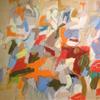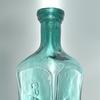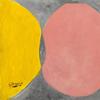A New Day Dawns at the Art Museums of Colonial Williamsburg with an Expanded Building, New Exhibitions and More
- WILLIAMSBURG, Virginia
- /
- July 27, 2020

The first large-scale expansion and upgrade to the building that houses the Art Museums of Colonial Williamsburg since they were first joined under one roof in 2007 is complete. Guests at the DeWitt Wallace Decorative Arts Museum and the Abby Aldrich Rockefeller Folk Art Museum (AARFAM) are now able to enjoy an enhanced visitor experience through a new wing that adds 65,000 square feet to the building, numerous improved amenities as well as several new exhibitions.
“Colonial Williamsburg’s collection reflects the scope and diversity of our shared history, and its objects tell remarkable stories that allow us to interpret that history,” said Ronald L. Hurst, Colonial Williamsburg’s Carlisle H. Humelsine chief curator and vice president for museums, preservation and historic resources. “We’ve been successful over the years in engaging guests through the Art Museums’ remarkable exhibitions and programs. Now, thanks to the generosity of our donors, we can offer an even more inviting, welcoming experience and share even more with our guests.”

The new Art Museums experience begins for visitors when they arrive at the new entrance, the Dixie D. Wolf Pavilion, located on South Nassau Street across from the pastoral site of the John Custis House and Garden. The entryway significantly improves public access to the building as well as enables better visibility of the complex for those visitors arriving on foot from Colonial Williamsburg’s Historic Area. Once inside, visitors are led directly into the main level of the building and greeted by a welcoming vista through a grand concourse, Wolf Hall, off of which can be found some of the enhanced amenities at the Art Museums. These include a new lobby and orientation space in addition to access to both museums. Also, the museum café and store, which can now be accessed without a ticket, are significantly enlarged and bathed in natural light through expansive, new windows overlooking the picturesque Bicentennial Park.

Additional improvements include guest services, such as considerably improved car parking and parking for the mobility challenged; the Colonial Williamsburg bus stop is now situated at the main entrance as well. New and upgraded mechanical and climate-control systems are also included in the new wing as is space and equipment for efficient operations and exhibition presentations. This entirely donor-financed, $41.7 million project, which broke ground in April 2017, has been one of the primary capital priorities of The Colonial Williamsburg Foundation’s recently completed $600 million comprehensive campaign.
“Colonial Williamsburg’s mission brings us face to face with our shared history, allowing us to engage with one another, and ourselves, about its importance and complexity,” said Cliff Fleet, president and CEO of The Colonial Williamsburg Foundation. “At the Art Museums of Colonial Williamsburg, we showcase the relevance of our material culture, from practical items of the past to familiar masterpieces. The museums expansion creates a larger showcase for the Foundation’s collections, and serves as a gathering place for guests and the community to have meaningful conversations about how far we have come as a nation and how far we have to go to form a more perfect union. We invite everyone to join us, and we thank the generous donors who made this all possible.”
Designed by Samuel Anderson Architects of New York City, the new wing to the Art Museums provides a 25-percent increase in gallery space, which allows guests the ability to see considerably more of these outstanding collections on view. New galleries are designated for an introduction to the collections as well as for folk art; coins, currency and medals; archaeology; musical instruments; costumes; maps, prints and drawings; toys and dollhouses; tools and weapons; architectural preservation; paintings; silver and metals; as well as an additional space for changing exhibitions.
To herald the expanded Art Museums are two new exhibitions in the AARFAM: The Art of Edward Hicks and American Folk Pottery: Art and Tradition. Edward Hicks (1780-1849), one of the country’s best-known folk artists, painted a series of more than five dozen paintings of the beloved biblical prophecy of the lion and lamb known as the Peaceable Kingdom. Colonial Williamsburg owns the largest single collection of material by Hicks, and this exhibition which celebrates the artist’s life and art, marks the first time these works have been on view together since 1999. The objects featured in American Folk Pottery mark a celebration of the form, function and whimsical flourishes of these clay vessels that were made for both their functionality and the needs of their communities. Through nearly 50 examples, the work of their makers reflects the regional styles and traditions that were passed down through generations and inspire many modern folk potters from this rich legacy. A third new exhibition, Early American Faces, will also premiere at the DeWitt Wallace Decorative Arts Museum. Through paintings and watercolors from both the Art Museums’ fine art and folk art collections, this exhibition will show visitors that the stories of all Americans—men, women, children, free, enslaved, American Indian, African American and people of European descent—are represented at these museums and within their collections. Some of the most iconic paintings in the collections, such as Charles Willson Peale’s Washington at the Battle of Princeton and Gilbert Stuart’s Portrait of Thomas Jefferson, will be on display. Also new at the Wallace museum is The Virginia-British Connection: British Paintings with Virginia Ties, a portraiture exhibition that illustrates the strong ties between the British colony and its motherland. Featured are portraits of British rulers as well as lesser British subjects; some lived for a time in Virginia, while others had an impact on life in the colony through their actions or achievements. Also included are English portraits of Virginia-born citizens.
These four new exhibitions accompany British Masterworks: Ninety Years of Collecting at Colonial Williamsburg, which opened at the Wallace Museum shortly before the museums closed due to COVID-19. Showcasing significant examples of British portraits, furniture and ornate decorative arts, these works had not been on view for many years until now.
Visitors can now support the Art Museums and their core educational mission as well through a membership program launched earlier this year that further ushers in the new era there. Both individual and family memberships are available and offer a variety of benefits including unlimited admission to the Art Museums and the Rockefellers’ home, Bassett Hall, for one year from date of purchase; a 25-percent discount on Art Museums single-day tickets for friends and family; a 10-percent discount on purchases at the Museum Café and Museum Store; exclusive members-only events; reduced prices for select programs in the Hennage Auditorium and much more. (For more information or to purchase an Art Museums membership, visit colonialwilliamsburg.org/joinart, call 855-296-6627 or visit Colonial Williamsburg ticketing locations.)
The Art Museums’ new era will continue throughout 2020 with more fascinating exhibitions opening later in the year. Among them will be Promoting America: Maps of the Colonies and the New Nation, which is scheduled to open in October and will explore how America’s indigenous peoples, flora, fauna and landscapes influenced iconography on maps of the continent and how those symbols changed, evolved or stayed the same over the course of two centuries. Featured in the exhibition will be maps that date from 1590, which depicts the “New World” as a literal Garden of Eden and will be on view for the first time, to an 1822 map celebrating the relatively newly established United States as well as recent acquisitions and other maps never before exhibited at the Art Museums. Another forthcoming exhibition, Keeping Time: Tall Case Clocks, which is scheduled to open in November, will examine how people kept time in the eighteenth century and how the new innovation for telling time to the exact minute was developed. Visitors will see more nearly 30 tall case clocks from different regions and spanning a century of timekeeping from 1700 to 1820.
Colonial Williamsburg reopened at reduced capacity on June 14 and continues to follow site-specific safety guidelines as part of the foundation’s COVID-19 business resumption plan and in accordance with the state’s plans for reopening. During Colonial Williamsburg’s reopening, most interpretive programming has been moved outdoors. For the safety of employees and the public, ticketed guests can expect limited interaction with interpretive staff. Site entry is limited by state-mandated capacity guidelines for social gatherings, and guests are encouraged to proceed quickly through interpretive sites to accommodate as many visitors as possible.
Face coverings are required while inside foundation-owned buildings and their use is encouraged outdoors as well. Guests are also asked to adhere to social distancing guidelines during their visit to Colonial Williamsburg sites, when walking along Duke of Gloucester Street and in other publicly accessible areas. Most doors, faucets and other high-traffic touchpoints are now touchless, and there are significantly enhanced cleaning protocols throughout the foundation’s open locations.
As America’s history endures, the Art Museums of Colonial Williamsburg is poised for the future. Their world-class collections will now be displayed in an equally high-quality facility, the region will gain a new place for its communities to gather safely and tourists will have an improved destination to visit.
Additional information about the Art Museums and Colonial Williamsburg as well as tickets are available online at colonialwilliamsburg.org, by calling (855) 296-6627 and by following Colonial Williamsburg on Facebook and @colonialwmsburg on Twitter and Instagram.
About the Art Museums of Colonial Williamsburg
The Art Museums of Colonial Williamsburg include the Abby Aldrich Rockefeller Folk Art Museum and the DeWitt Wallace Decorative Arts Museum. The Abby Aldrich Rockefeller Folk Art Museum is home to the nation’s premier collection of American folk art, with more than 7,000 folk art objects made during the 18th, 19th and 20th centuries. The DeWitt Wallace Decorative Arts Museum exhibits the best in British and American fine and decorative arts from 1670–1840. The Art Museums of Colonial Williamsburg are located at 301 South Nassau Street in Williamsburg, Va. Open daily from 9:00 A.M. to 6:00 P.M.
About The Colonial Williamsburg Foundation
Colonial Williamsburg operates the world’s largest living history museum, preserving Virginia’s 18th-century capital as a fully functioning city. Fun, engaging experiences transport guests back in time and highlight the relevance of America’s founding era to contemporary life. The Colonial Williamsburg experience includes more than 600 restored or reconstructed buildings, historic trade shops, renowned museums of decorative arts and folk art, extensive educational outreach programs for students and teachers, lodging, culinary options from historic taverns to casual or elegant dining, the Golden Horseshoe Golf Club featuring 45 holes designed by Robert Trent Jones Sr. and his son Rees Jones, a full-service spa and fitness center managed by Trilogy Spa, pools, retail stores and gardens. Philanthropic support and revenue from admissions, products and hospitality operations sustain Colonial Williamsburg’s educational programs and preservation initiatives.
# # #
Contact:
Robyn LiverantRobyn Liverant Public Relations
robyn@robynliverant.com
301 South Nassau Street
Williamsburg, Virginia
855 296 6627
http://colonialwilliamsburg.org
About The Art Museums of Colonial Williamsburg
The Art Museums of Colonial Williamsburg include the Abby Aldrich Rockefeller Folk Art Museum and the DeWitt Wallace Decorative Arts Museum. The Abby Aldrich Rockefeller Folk Art Museum is home to the nation's premier collection of American folk art, with more than 7,000 folk art objects made during the 18th, 19th and 20th centuries. The DeWitt Wallace Decorative Arts Museum exhibits the bests in British and American fine and decorative arts from 1670-1840. The Art Museums of Colonial Williamsburg are located at 301 South Nassau Street in Williamsburg, VA. Open daily from 9:00 A.M. to 6:00 P.M.
















